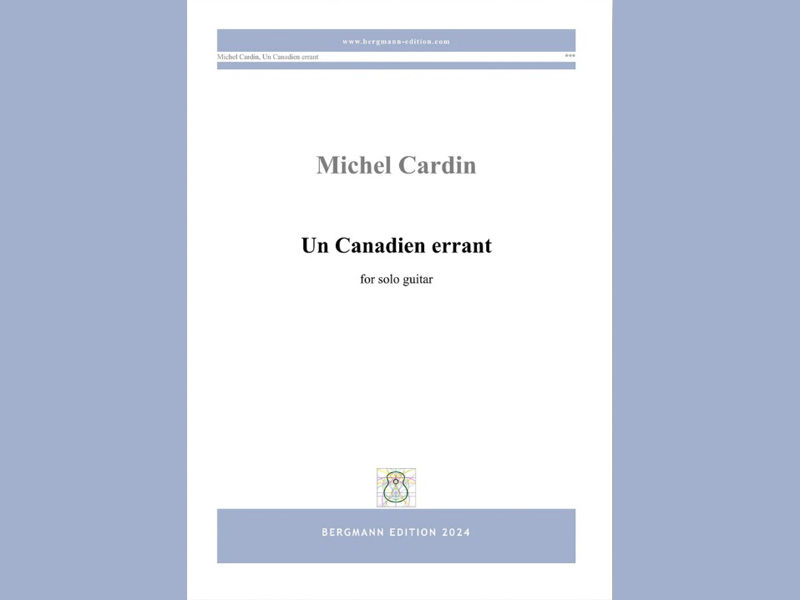Richard Alexander Vaughan : Postcards from Spain: Bergmann
- chrisdumigan
- May 14, 2021
- 4 min read
Updated: Jun 5, 2022

Richard Alexander Vaughan
Bergmann Edition: 33 pages
www.bergmann-edition.com
This set of ten pieces are substantial works that require a very good player to do them full justice, and the first thing you notice is that, like Claude Debussy before him, in his 24 Preludes for piano, the titles are in brackets at the end, rather than at the start. Taking Debussy’s explanation because Vaughan hasn’t said why, I assume that he didn’t want the titles to colour the way that we play the pieces, but rather to treat them as merely pieces of music, hence the decision to put the titles at the very end.
No1 (The Journey) is set in Gm with the 5th string dropped to a G, and the 6th to a D. The first thing that strikes the guitarist is just how many times the middle voices are on the constant move, so that the (usually) three strands of music are never still for even a moment! This firstly makes for some beautiful music, wonderfully harmonised, and secondly, makes it really tough to play. So one has to very careful of the LH fingers that you decide to use, because there are many moments when you might struggle to keep the voices going exactly as written.
No2 , an Andante Cantabile set in E major and its title is Barcarolle, and therefore as you might expect , it is in 6/8.Again the number of moving parts make this tricky, but consistently interesting to manoeuvre around. The second theme moves to G Major and after changing back to E major once again, then has a section in the tonic minor which is somewhat easier. Keys change swiftly here as the next section turns into 2 sharps and Bm, before a final reprise of the opening leading to a gentle coda in E.
Master of the Revels , No3 again exhibits Vaughan’s unusually vivid way of harmonizing melodies – a way that is completely tonal but constantly on the move. They do all work beautifully on the guitar you understand, but at first glance the player might (wrongly) think that they are written by a non- player and that someone has arranged them a little. This is not to denigrate his writing at all as they do work beautifully well, but they are so individual in style that it does take some work to get them to be smooth enough to play. This piece is marked Allegro Con Bravado and in spite of being in Am , has several moments when other keys appear even momentarily, which again makes the music complex and utterly gripping to play.
No4 , Absent Friends is a moving tribute to the late Chris Kilvington who among many other things wrote for Classical Guitar and someone I met many times over the years. This Dm Adagio,, and later D Major , Moderato piece is emotive and very satisfying to play.
No5 Duende is also quiet and emotive, is set in Dm like its predecessor, and needs to be smoothly played throughout. There are moreover a few places where your fingering decisions are essential to keeping the legato flow going too.
No6 Touchwood Waltz has a few moments where the chords change beat by beat from one to the next, and that makes for some tricky moments , but otherwise this is a most individually harmonised piece that makes for very interesting playing.
The Orxeta Fiesta that is No7 is perhaps the trickiest of the 10 as its Allegretto speed marking belies the fact that everything is on the move quaver by quaver throughout , and diving as it does all around the fingerboard , it is both fascinatingly exciting and very difficult.
No8, The Dancers is very rhythmic and flows beautifully around even though the melody and its harmonies jump around constantly from one part of the fingerboard to the next , for Vaughan’s musical imagination when writing his pieces (as far as this set is concerned) is unlike any other writer that I am acquainted with. Nothing is like anything you have seen before written for the guitar – such is his individuality.
Para Orxeta (No9) begins Adagio over a consistent but offbeat drone E 6th, while the melody and harmonies above are always on the move. This then suddenly turns into a Piu Mosso where, after a bar of 44 demi – semi quavers grouped into 11 notes a beat, becomes several bars of rasgueado chords before returning briefly to the opening and a surprising coda.
The final No10, Goodbye is very deeply felt and has a two bar, two chord motif that underpins some of the most important parts. This briefly changes in the middle only to return for the real goodbye at the end. This was fittingly apt piece to end the set with.
This is one of the most original set of pieces by a composer I am sad to say I had never previously heard of. They are utterly individual, and like nothing you may have seen or heard before on a guitar, usually very tricky to play, but exceedingly worth the effort to try getting them under your fingers. Fabulous! I shall be looking out for more from this writer in the future.
Chris Dumigan




Comments